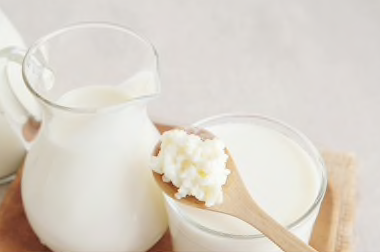The Caucasus Mountains - diving Russia from Georgia and Azerbaijan, spanning between the Black and Caspian Seas
Kefir has a fascinating history originating in the Caucasus Mountains, which span the land bridge between the Black and Caspian seas, and divide Russia on north side from Georgia, Armenia, and Azerbaijan on the south side. Turkey is located further to the south, and all have a tradition of kefir creation and consumption. Once a jealously guarded ancient secret, kefir has spread to mainstream consciousness recently due to the love affair of all things probiotic.
There are stories of kefir being a gift of the prophet Mohammed to nomadic herd-tending humans in the region. Shepherds of the Caucasus would transport milk in sheepskins with a resulting fermentation of a tangy milk product that was preserved at ambient temperature. Mohammed warned the families of the area not to share the secret or face losing the health- and life-extending properties of the beverage, so the kefir tradition was protected for a long time. According to one story, around 1900 Russians wanted this magical drink and sent a beautiful Russian spy to extract the grains from a Caucasus prince at the time. Things went a bit sideways for a while, I’ll let you read the story, but eventually (surprise) the Russians got what they wanted, and now it’s a national beverage phenomenon. Especially the morning after drinking too much vodka.
Milk substrate, kefir and kefir grains
Currently, kefir can be bought as a pre-mixed, fermented, strained and bottled milk drink, or as kefir “grains”, small white cauliflower-like clusters of culture to mix into milk and make one’s own continuous culture. It cultures well and quickly at room temperature (21C/75F), but can also be temporarily suspended in the fridge, or even frozen for later use. Kefir has been touted as a cure-all for everything, but delving more deeply into the science reveals that some of these claims are not unfounded, and kefir may be one of the reasons that people from the Caucasus are some of the healthiest and longest-lived in the world.
Microbiology, our microbiome, and kefir’s effect on human health:
Here is a fascinating article about how ingested microorganisms in kefir may interact with our brain chemistry, boosting mood. A small quote: “A number of studies have suggested that the consumption of fermented foods, such as kefir, are associated with an improvement in mood in humans, but the reasons for this benefit was not clear. One way in which fermented foods could alter our behaviour is by changing the community of bacteria in our gut. It has become clear that these bacteria can communicate with our brain by producing chemicals called neurotransmitters, and this communication is referred to as the “gut-brain axis”.
Here is some pretty interesting microscopy looking at a kefir grain. Top Left is a vesicle dissected out of a bunch of grains. Top right is a cross section of the wall. Bottom left is the outer surface of the grain, and bottom left is the inner surface. I find it very interesting that the outside surface is so populated, and the inner lumen (hollow part) is more bare of organisms.
The bacterial genera most commonly found in kefir using culture dependent techniques are Lactobacillus, Lactococcus, Streptococcus, and Leuconostoc. There have been numerous studies on kefir’s benefits, as well as the polysaccharide “kefiran” which gives kefir it’s unique viscosity. Kefir/Kefiran have demonstrated antitumor, antifungal, antibacterial properties, as well as involvement in immunomodulation, epithelium protection, anti-inflammatory, healing, and antioxidant activity (see linked article).
https://www.healthline.com/nutrition/9-health-benefits-of-kefir#section3
Kefir is incredibly easy to make if you have the grains. Keeping them alive and well over time take a bit of care and babysitting, but one can also pause them in the fridge or arrest them in the freezer. (Recipe and care here).
Uses for kefir
drink it straight up or pour it onto your cereal - it’s a probiotic tangy milk substitute. I like to mix mine with 1/2 C of juice: blueberry, pomegranate or tart cherry as a drink.
use it as a milk, buttermilk or cream substitute in baking and cooking. Note that you’ll get the tangy flavor, but the probiotics will be killed by heat.
make a tangy, creamy, lower in saturated fat, probiotic salad/cooked vegetable dressing by substituting kefir as an ingredient instead of cream.
slightly different spin on smoothies or lassis by using kefir instead of yogurt.
strain it overnight in cheesecloth or a coffee filter like you would yogurt, to create a delicious and tangy cream-cheese-like probiotic kefir spread (additions: snipped herbs, squeeze of garlic for savory spreads, or go sweet and add cinnamon, orange zest and fresh ginger to top a carrot muffin)
stir it into borscht,
lots of recipes here if you have leftover kefir
one can apparently use coconut milk or non dairy milks, but it’s advised to give it a dairy cycle every so often. (I have not tried a non-dairy experiment yet.)
Exposure to metal can weaken the kefir grains, so avoid metal utensils.
Temperatures above 90 °F can cause the milk to spoil.
Keep the jar away from direct sunlight.
The strained kefir grains can be kept to make new batches.
Shake it if it starts to separate while being stored.
To make a fruit-flavored kefir, chop up fruit and add it to the strained kefir. Let it sit for an additional 24 hours. Re-strain if desired.
storage and revival:
https://kefirko.com/kefir/how-to-take-break-from-making-kefir/
https://kefirko.com/kefir/5-steps-revive-milk-kefir-grains/
https://www.culturesforhealth.com/learn/milk-kefir/how-to-find-milk-kefir-grains/
http://users.sa.chariot.net.au/~dna/kefirpage.html#traditional-kefir
medical/science reviews:
https://www.ncbi.nlm.nih.gov/pmc/articles/PMC4854945/



